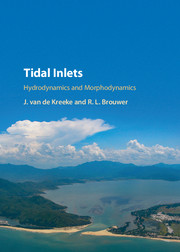Book contents
- Frontmatter
- Contents
- Preface
- 1 Introduction
- 2 Geomorphology
- 3 Sand Transport Pathways
- 4 Sand Transport and Sand Bypassing at Selected Inlets
- 5 Empirical Relationships
- 6 Tidal Inlet Hydrodynamics; Excluding Depth Variations with Tidal Stage
- 7 Tidal Inlet Hydrodynamics; Including Depth Variations with Tidal Stage
- 8 Cross-Sectional Stability of a Single Inlet System
- 9 Cross-Sectional Stability of a Double Inlet System, Assuming a Uniformly Varying Basin Water Level
- 10 Cross-Sectional Stability of a Double Inlet System, Assuming a Spatially Varying Basin Water Level
- 11 Morphodynamic Modeling of Tidal Inlets Using a Process-Based Simulation Model
- 12 Morphodynamic Modeling of Tidal Inlets Using an Empirical Model
- 13 River Flow and Entrance Stability
- 14 Engineering of Tidal Inlets
- References
- Index
12 - Morphodynamic Modeling of Tidal Inlets Using an Empirical Model
Published online by Cambridge University Press: 04 July 2017
- Frontmatter
- Contents
- Preface
- 1 Introduction
- 2 Geomorphology
- 3 Sand Transport Pathways
- 4 Sand Transport and Sand Bypassing at Selected Inlets
- 5 Empirical Relationships
- 6 Tidal Inlet Hydrodynamics; Excluding Depth Variations with Tidal Stage
- 7 Tidal Inlet Hydrodynamics; Including Depth Variations with Tidal Stage
- 8 Cross-Sectional Stability of a Single Inlet System
- 9 Cross-Sectional Stability of a Double Inlet System, Assuming a Uniformly Varying Basin Water Level
- 10 Cross-Sectional Stability of a Double Inlet System, Assuming a Spatially Varying Basin Water Level
- 11 Morphodynamic Modeling of Tidal Inlets Using a Process-Based Simulation Model
- 12 Morphodynamic Modeling of Tidal Inlets Using an Empirical Model
- 13 River Flow and Entrance Stability
- 14 Engineering of Tidal Inlets
- References
- Index
Summary
Introduction
Process-based models are a valuable tool when the relevant timescales are measured in months to years (Section 11.5). For timescales of decades to centuries, recourse is often taken to empirical models, also referred to as long-term behavior models or aggregate models. Empirical models start with the premise that, after a perturbation, the morphology tends towards an equilibrium state. The equilibrium is defined by equations of state. Examples are the relationship between inlet cross-sectional area and tidal prism (Eqs. (5.1) and (5.2)) and the relationship between ebb delta volume and tidal prism (Eq. (5.14)). Examples of perturbations are changes in the inlet morphology resulting from a storm and changes resulting from such engineering activities as dredging and basin reduction. The objective of empirical modeling is to predict the transition from the old to the new equilibrium.
Modeling Concepts
In applying empirical modeling to tidal inlets, the morphology is divided into a number of large-scale geomorphic elements, e.g., inlet, ebb delta and flood delta. Each of these elements is viewed on an aggregated scale and characterized by either a sand or a water volume. When themorphology as a whole tends to an equilibrium, so do the individual elements.
Examples of empirical models are presented in Kraus (2000), van de Kreeke (2006) and Stive et al. (1998). Kraus (2000) applied an empirical model to simulate the ebb delta development after the opening of Ocean City Inlet (MD). van de Kreeke (2006) used a similar empirical model to explain the transition from the old to the new equilibrium of the Frisian Inlet (The Netherlands) after basin reduction. In both studies, the sand transport entering and leaving an element is prescribed in terms of the ratio between the actual and equilibrium sand or water volume of the element. The model by Stive et al. (1998) is fundamentally different from the models used by Kraus (2000) and van de Kreeke (2006) in that the sand transport entering and leaving an element is formulated as a diffusive transport.
Information
- Type
- Chapter
- Information
- Tidal InletsHydrodynamics and Morphodynamics, pp. 120 - 138Publisher: Cambridge University PressPrint publication year: 2017
